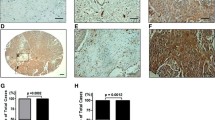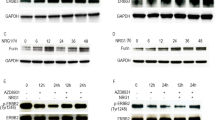Abstract
The present study investigated the modulatory role of transforming growth factor beta 1 (TGFβ1) on the secretion of matrix metalloproteinases (MMPs) and tested whether the altered secretion of MMPs could directly affect the invasive behavior of ovarian cancer cells. To this aim, human ovarian cancer SKOV3 cells were treated once with vehicle or various concentrations of TGFβ1 for 24 h. Gelatinase activities in conditioned media were analyzed by zymography and densitometry. TGFβ1 dose-dependently stimulated the secretion of a 68-kDa gelatinase, which was characterized as an MMP because its activity was inhibited by a metalloproteinase inhibitor 1,10-phenanthroline, and by a synthetic MMP inhibitor BB3103. In addition, we used aminophenylmercuric acetate (APMA) to activate latent gelatinases. APMA time-dependently decreased the activity of 68-kDa gelatinase, and increased the activities of 64- and 62-kDa gelatinolytic bands. The 68-kDa gelatinase was further characterized as MMP2 (gelatinase A) by immunoblotting analysis. We then tested TGFβ1 effect on the invasive potential of SKOV3 cells as assessed by the migration ability through reconstituted basement membrane, and further investigated whether TGFβ1 may act through modulating the MMP activity to affect ovarian cancer cell invasion. The results show that TGFβ1 stimulated the invasive behavior of SKOV3 cells, and that MMP inhibitor BB3103 abrogated this effect of TGFβ1. In conclusion, this study indicates that TGFβ1 may act partly through stimulating the secretion of MMP in promoting the invasive behavior of human ovarian cancer cells. Furthermore, this work supports the idea that specific MMP inhibitors of the hydroxamate class could be therapeutically useful in controlling cancer cell invasion/metastasis.
Similar content being viewed by others
References
Richardson GS, Scully RE, Nikrui N et al. Common epithelial cancer of the ovary. N Engl J Med 1985; 321: 474–83.
Silverberg E, Boring CC, Squires TS. Cancer statistics. CA-Cancer J Clin 1990; 40: 9–19.
Berek JS, Martinez-Maza O. Molecular and biologic factors in the pathogenesis of ovarian cancer. J Reprod Med 1994; 39: 241–8.
Sporn MB. The war on cancer. Lancet 1996; 347: 1377–81.
Stetler-Stevenson WG, Liotta LA, Kleiner DE Jr. Extracellular matrix 6: Role of matrix metalloproteinases in tumor invasion and metastasis. FASEB J 1993; 7: 1434–41.
Woessner JF Jr. Matrix metalloproteinases and their inhibitors in connective tissue remodeling. FASEB J 1991; 5: 2145–54.
Bonfil RD, Reddel RR, Ura H et al. Invasive and metastatic potenial of a v-Ha-ras-transformed human bronchial epithelial cell line. J Natl Cancer Inst 1989; 81: 587–94.
Mignatti P, Rifkin DB. Biology and biochemistry of proteinases in tumor invasion. Physiol Rev 1993; 73: 161–95.
Moser T L, Young TN, Rodriguez GC et al. Secretion of extracellular matrix-degrading proteinases is increased in epithelial ovarian carcinoma. Int J Cancer 1994; 56: 552–9.
Powell WC, Knox JD, Navre M et al. Expression of the metalloproteinase matrilysin in DU-145 cells increases their invasive potential in severe combined immunodeficient mice. Cancer Res 1993; 53: 417–22.
Sreenath T, Martrisian LM, Stetler-Stevenson W et al. Expression of matrix metalloproteinase genes in transformed rat cell lines of high and low metastatic potential. Cancer Res 1992; 52: 4942–7.
Thompson EW, Yu M, Bueno J et al. Collagen induced MMP-2 activation in human breast cancer. Breast Cancer Res Treat 1994; 31: 357–70.
Afzal S, Lalani EI-N, Foulkes WD et al. Matrix metalloproteinase-2 and tissue inhibitor of metalloproteinase-2 expression and synthetic matrix metalloproteinase-2 inhibitor binding in ovarian carcinomas and tumor cell lines. Lab Invest 1996; 74: 406–21.
Autio-Harmainen H, Karttunen T, Hurskainen T et al. Expression of 72 kilodalton type IV collagenase (gelatinase A) in benign and malignant ovarian tumors. Lab Invest 1993; 69: 312–21.
Campo E, Merino MJ, Tavassoli FA et al. Evaluation of basement membrane components and the 72 kDa type IV collagenase in serous tumors of the ovary. Am J Surg Pathol 1992; 16: 500–7.
Naylor MS, Stamp GW H, Davies B et al. Expression and activity of MMPs and their regulators in ovarian cancer. Int J Cancer 1994; 58: 50–6.
Albini A, Melchiori A, Santi L et al. Tumor cell invasion inhibited by TIMP-2. J Natl Cancer Inst 1991; 83: 775–9.
Hendrix MJ, Wood WR, Seftor EA et al. Retinoic acid inhibition of human melanoma cell invasion through a reconstituted basement membrane and its relation to decreases in the expression of proteolytic enzymes and motility factor receptor. Cancer Res 1990; 50: 4121–30.
Khokha R, Zimmer MJ, Graham CH et al. Suppression of invasion by inducible expression of tissue inhibitor of metalloproteinase-1 (TIMP-1) in B16-F10 melanoma cells. J Natl Cancer Inst 1992; 84: 1017–22.
Khokha R. Suppression of the tumorigenic and metastatic abilities of murine B16-F10 melanoma cells in vivo by the overexpression of the tissue inhibitor of metalloproteinase-1. J Natl Cancer Inst 1994; 86: 299–304.
Koop S, Khokha R, Schmidt EE et al. Overexpression of metalloproteinase inhibitor in B16F10 cells does not affect extravasation but reduces tumor growth. Cancer Res 1994; 54: 4791–7.
Brown PD, Levy AT, Margulies IM et al. Independent expression and cellular processing of Mr 72,000 type IV collagenase and interstitial collagenase in human tumorigenic cell lines. Cancer Res 1990; 50: 6184–91.
Matrisian JM. The matrix-degrading metalloproteinases. BioEssays 1992; 14: 455–62.
Ogata Y, Pratta MA, Nagase H et al. Matrix metalloproteinase 9 (92-kDa gelatinase/type IV collagenase) is induced in rabbit articular chondrocytes by cotreatmemt with interleukin 1 beta and a protein kinase C activator. Exp Cell Res 1992; 210: 245–9.
Weinberg WC, Brown PD, Stetler-Stevenson WG et al. Growth factors specifically alter hair follicle cell proliferation and collagenolytic activity alone or in combination. Differentiation 1990; 45: 168–78.
Gorsch SM, Memoli VA, Stukel TA et al. Immunohistochemical staining for transforming growth factor β1 associates with disease progression in human breast cancer. Cancer Res 1992; 52: 6949–52.
Shimizu S, Nishikawa Y, Kuroda K et al. Involvement of transforming growth factor β1 in autocrine enhancement of gelatinase B secretion by murine metastatic colon carcinoma cells. Cancer Res 1996; 56: 3366–70.
Massague J. The transforming growth factor-β family. Annu Rev Cell Biol 1990; 6: 597–641.
Akhurst RJ, Balmain A. Genetic events and the role of TGFβ in epithelial tumor progression. J Pathol 1999; 187: 82–90.
Travers MT, Barrett-Lee PJ, Berger U et al. Growth factor expression in normal, benign, and malignant breast tissue. BMJ 1988; 296: 1621–4.
Steiner MS, Barrack ER. Transforming growth factor-β1 overproduction in prostate cancer: effects on growth in vivo and in vitro. Mol Endocrinol 1992; 6: 15–25.
Friess H, Yamanaka Y, Buchler M et al. Enhanced expression of transforming growth factor-β isoforms in pancreatic cancer correlates with decreased survival. Gastroenterology 1993; 105: 1846–56.
Ito N, Kawata S, Tamura S et al. Elevated levels of transforming growth factor β messenger RNA and its polypeptide in human hepatocellular carcinoma. Cancer Res 1989; 51: 4080–3.
Gomella LG, Sargent ER, Wade TP et al. Expression of transforming growth factor α in normal human adult kidney and enhanced expression of transforming growth factors α and β1 in renal cell carcinoma. Cancer Res 1989; 49: 6972–5.
Jennings MT, Maciunas RJ, Carver R et al. TGF-β1 and TGF-β2 are potent growth regulators for low-grade and malignant gliomas in vitro: evidence in support of an autocrine hypothesis. Int J Cancer 1991; 49: 129–39.
Niitsu Y, Urushizaki Y, Koshida Y et al. Expression of TGF-beta gene in adult T cell leukemia. Blood 1988; 71: 263–6.
Bristow RE, Baldwin RL, Yamada SD et al. Altered expression of transforming growth factor-β ligands and receptors in primary and recurrent ovarian carcinoma. Cancer 1999; 85: 58–668.
Gordinier ME, Zhang HZ, Patenia R et al. Quantitative analysis of transforming growth factor β1 and 2 in ovarian carcinoma. Clin Cancer Res 1999; 5: 2498–2505.
Maehara Y, Kakeji Y, Kabashima A et al. Role of transforming growth factor-beta 1 in invasion and metastasis in gastric carcinoma. J Clin Oncol 1999; 17: 607–14.
Albo D, Berger DH, Wang T N et al. Thrombospondin-1 and transforming growth factor-beta1 promote breast tumor cell invasion through up-regulation of the plasminogen/plasmin system. Surgery 1997; 122: 493–9.
Walker RA, Dearing SJ, Gallacher B. Relationship of transforming growth factor β1 to extracellular matrix and stromal infiltrates in invasive breast carcinoma. Br J Cancer 1994; 69: 1160–5.
Beckett RP, Davidson AH, Drummond AH et al. Recent advances in matrix metalloproteinase inhibitor research. Drug Discov. Today 1996; 1: 16–26.
Talbot DC, Brown PD. Experimental and clinical studies on the use of matrix metalloproteinase inhibitors for the treatment of cancer. Eur J Cancer 1996; 32A: 2528–33.
Eccles SA, Box GM, Court WJ et al. Control of lymphatic and hematogenous metastasis of a rat mammary carcinoma by the matrix metalloproteinase inhibitor batimastat (BB94). Cancer Res 1996; 56: 2815–22.
Davies B, Brown PD, East N et al. Synthetic matrix metalloproteinase inhibitor decreases tumor burden and prolongs survival of mice bearing human ovarian carcinoma xenografts. Cancer Res 1993; 53: 2087–91.
Giavazzi R, Garofalo A, Ferri C et al. Batimastat, a synthetic inhibitor of matrix metalloproteinase, potentiates the antitumor activity of cisplatin in ovarian carcinoma xenografts. Clin Cancer Res 1998; 4: 985–92.
Haq M, Shafii A, Zervos EE et al. Addition of matrix metalloproteinase inhibition to conventional cytotoxic therapy reduces tumor implantation and prolongs survival in a murine model of human pancreatic cancer. Cancer Res 2000; 60: 3207–11.
Ancuta P, Fahmi H, Pons J-F et al. Involvement of the membrane form of tumor necrosis factor-α in lipopolysaccharide-induced priming of mouse peritoneal macrophages for enhanced nitric oxide response to lipopolysaccharide. Immunology 1997; 92: 259–66.
Hahm HA, Ip MM. Primary culture of normal rat mammary epithelial cells within a basement membrane matrix, I. Regulation of proliferation by hormones and growth factors. In Vitro Cell Dev Biol 1990; 26: 791–802.
Hwang J-J, Lin S-W, Teng C-H et al. Relaxin modulates the ovulatory process and increases secretion of different gelatinases from granulosa and theca-interstitial cells in rats. Biol Reprod 1996; 55: 1276–83.
Hibbs MS, Hasty KA, Seyer JM et al. Biochemical and immunological characterization of the secreted forms of human neutrophil gelatinase. J Biol Chem 1985; 260: 2493–500.
Salamonsen LA, Nagase H, Suzuki R et al. Production of matrix metalloproteinase 1 (interstitial collagenase) and matrix metalloproteinase 2 (gelatinase A; 72kDa gelatinase) by ovine endometrial cells in vitro: Different regulation and preferential expression by stromal fibroblasts. J Reprod Fertil 1993; 98: 583–9.
Albini A, Iwamoto Y, Kleinman K et al. A rapid in vitro assay for quantitating the invasive potential of tumor cells. Cancer Res 1987; 47: 3239–45.
Welch DR, Fabra A, Nakajima M. Transforming growth factor β stimulates mammary adenocarcinoma cell invasion and metastatic potential. Proc Natl Acad Sci USA 1990; 87: 7678–82.
Melchiori A, Albini A, Ray JM et al. Inhibition of tumor cell invasion by a conserved peptide sequence from the matrix metalloproteinase enzyme prosegment. Cancer Res 1992; 52: 2353–6.
Hanahan D, Weinberg RA. The hallmarks of cancer. Cell 2000; 100: 57–70.
Author information
Authors and Affiliations
Rights and permissions
About this article
Cite this article
Lin, SW., Lee, MT., Ke, FC. et al. TGFβ1 stimulates the secretion of matrix metalloproteinase 2 (MMP2) and the invasive behavior in human ovarian cancer cells, which is suppressed by MMP inhibitor BB3103. Clin Exp Metastasis 18, 493–499 (2000). https://doi.org/10.1023/A:1011888126865
Issue Date:
DOI: https://doi.org/10.1023/A:1011888126865




